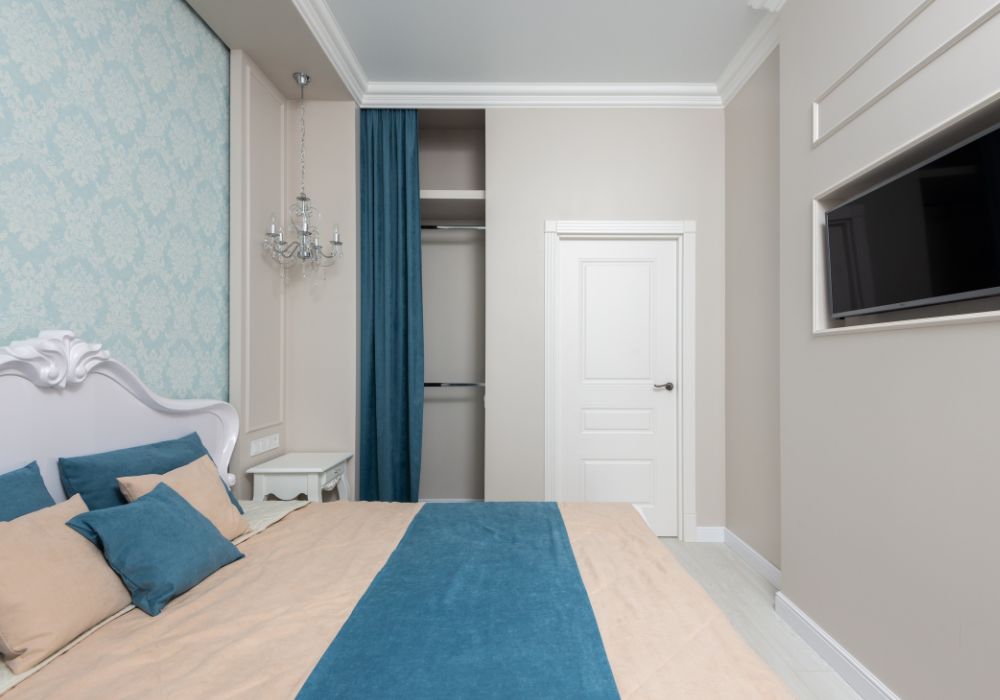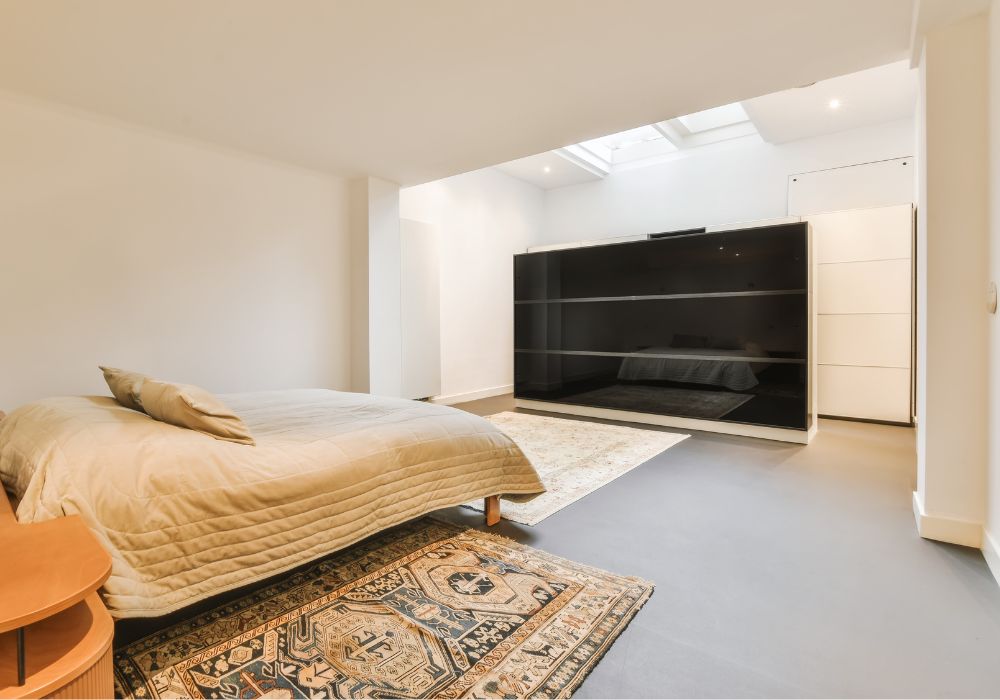The best place to put a TV in the bedroom is typically on the wall directly across from the bed at eye level when sitting or lying down.
We all want that perfect setup where we can unwind and catch our favorite shows without straining our necks or cluttering up the space.
But worry not because this guide will delve into the art and science of TV placement in your bedroom.
Whether you’re all about wall-mounting for that sleek, modern look or prefer the classic TV stand setup, we’ve got you covered.
Where To Put A TV In A Bedroom?
When setting up a TV in your bedroom, finding the perfect spot is essential for a comfortable and enjoyable viewing experience.
With various options available, it’s crucial to consider factors like viewing angles, room layout, and personal preferences.
The following are ten different placement ideas to help you make the best decision for your space.
1. On a Dresser
A TV on a dresser is a popular choice for many bedroom setups. It provides a convenient and accessible location, especially if the dresser is directly across from the bed.
Ensure the dresser is wide enough to comfortably accommodate the TV’s base and allow proper ventilation to prevent overheating.
2. On the Wall Next to the Bed
Wall mounting the TV beside the bed is a sleek and space-saving option. This placement allows for a clear view from the bed without taking up any floor space.
Ensure the TV is positioned at eye level when sitting up in bed, and use a sturdy wall mount bracket rated for the size and weight of your TV.
3. In a Built-In Entertainment Unit
If your bedroom has a built-in entertainment unit, this can be an excellent spot for your TV.
These units are designed to integrate technology and provide ample storage for media accessories seamlessly.
Ensure the team has proper cable management options to keep the area organized and clutter-free.
4. In a Corner Mount
For bedrooms with limited wall space, consider a corner mount. This placement maximizes space efficiency and allows for flexible furniture arrangements.
Ensure the TV is positioned at an angle that provides a comfortable viewing experience from various room parts.
5. Above a Fireplace
For rooms with a fireplace, mounting the TV above it can create a focal point and a cozy atmosphere. However, it’s crucial to ensure the heat from the fireplace won’t damage the TV.
Use a heat-resistant mount and maintain a safe distance between the TV and the fire.
6. From the Ceiling
Ceiling mounts are a unique and space-saving option. This placement is ideal for bedrooms with limited wall space.
Ensure the mount is securely anchored to a ceiling beam to support the TV’s weight.
7. In a Pop-Up Cabinet
A pop-up cabinet conceals the TV when it’s not in use, preserving the room’s aesthetics. When it’s time to watch, the TV elevates from the cabinet.
Ensure the cabinet has proper ventilation to prevent overheating.
8. On a Retractable Mount
A retractable mount lets you pull the TV out when you want to watch and push it back when you’re done. This is an excellent option for bedrooms where floor space is at a premium.
Ensure the mount is installed securely to support the weight of the TV.
9. Behind a Two-Way Mirror
Consider placing the TV behind a two-way mirror for a futuristic, space-saving option. When the TV is off, it functions as a reflective surface.
Ensure the mirror is transparent enough for a clear view of the TV.
10. Within a Custom Cabinet
A custom cabinet can be designed to fit your TV and blend seamlessly with your bedroom’s decor. This option provides ample storage for media accessories.
Ensure the cabinet has proper ventilation to prevent overheating.
Where To Put A TV In A Narrow Bedroom?

I know firsthand how tricky it can be to find the right spot for a TV in a narrow bedroom. You can make it work like a charm with some creativity and strategic thinking.
- A wall mounting. By elevating the TV, you free up precious floor area. Just ensure it’s at eye level when seated comfortably on your bed.
- A dresser. It’s a smart move, especially if it’s opposite your bed. Measure twice, place once – ensure the dresser has enough width to hold the TV comfortably.
- Using corner mounts. You’re maximizing every inch of the room by tucking the TV into a corner. Plus, it gives you some flexibility in arranging your furniture.
- A pop-up cabinet. It rises from its hiding place when it’s showtime, and when it’s curtain call, it disappears. This keeps things looking sleek and uncluttered.
- Ceiling mounting. This can be a game-changer if your floor space is on the endangered species list. It’s unexpected but super effective.
Remember, it’s not just about where but also about how. Cable management is your best friend. Tidy up those cords, and suddenly, everything looks ten times more organized.
Things To Consider When Planning Where To Put a TV In the Bedroom

A TV in the bedroom can transform it into a cozy retreat where you can unwind and catch up on your favorite shows. But before mounting or placing your TV, consider a few essential things.
- Bed Positioning Matters
Think about where your bed is located. Ideally, you want the TV visible from your bed without straining your neck or eyes. It’s like setting up your little theater right in your home.
- Viewing Angle Is Key
Imagine settling in for a binge-watching session, only to realize you must crane your neck to see the screen correctly. Ensure your TV is at a comfortable eye level from your viewing spot.
- Wall Mount vs. Stand Dilemma
You’ll need to decide: wall mount or TV stand. Wall mounting saves floor space and looks sleek, but it’s more permanent. On the other hand, a frame gives you flexibility in placement and allows for additional storage.
- Safety First
Ensure the TV is securely placed or mounted to prevent accidental slips or falls. If you have kids or pets, consider a higher placement to keep it out of their reach.
- Complement Your Decor
Your bedroom should be a reflection of your style, and that includes your TV setup. Consider how the TV fits into your overall decor scheme. It can be a statement piece or subtly blend in, enhancing the ambiance.
- Cable Management
Nothing kills the mood like a jumble of cables snaking around your room. Invest in some cable management solutions to keep things tidy.
- Sound Check
The sound quality is just as important as the visuals. Consider if you need additional speakers or a soundbar to enhance your audio experience.
- Multi-Functional Furniture Solutions
If your bedroom is smaller, consider furniture that can do double duty. A media console with storage or a bed with a built-in TV lift can save space and add functionality.
- Seek Professional Installation
While DIY is admirable, sometimes it’s best to call in the experts, especially regarding mounting. They’ll ensure everything is secure and safe.
- Finishing Touches for a Neat Setup
Add some finishing touches. Conceal those cables, arrange some decor around the TV, and step back to admire your handiwork.
Is It OK To Put a TV in the Bedroom?
Yes, having a TV in the bedroom is outstanding, as long as it’s approached thoughtfully.
Many people find it a convenient and enjoyable way to unwind and relax. But, it’s essential to consider factors like placement, viewing distance, and ergonomics to ensure a comfortable and enjoyable viewing experience.
Be mindful of creating a balanced and aesthetically pleasing bedroom setup that incorporates the TV seamlessly into the space.
Is It OK To Sleep Next To a TV?

Sleeping next to a TV can adversely affect your sleep quality.
The blue light emitted by the screen can interfere with your body’s natural production of melatonin, the hormone responsible for regulating your sleep-wake cycle.
This can make it more difficult to fall asleep and stay asleep throughout the night.
Furthermore, the noise from the TV can be disruptive to your sleep. Even at a low volume, it can act as a continuous background noise that may prevent you from entering into deeper stages of sleep.
This can leave you feeling groggy and less refreshed in the morning.
Can a TV Be Too Big For a Bedroom?

Yes, a TV can be too big for a bedroom, depending on the size of the room and the viewing distance.
If the TV is so large that it dominates the entire wall or takes up most of the available space, it might overwhelm the room and make it feel cramped.
And, if you’re sitting too close to a huge TV, it can lead to discomfort and eye strain.
Then there’s the matter of aesthetics. A disproportionately large TV can throw off the room’s balance and make it feel cluttered.
It’s like trying to fit a king-sized bed in a small bedroom – it just doesn’t quite work.
What Size TV Is Best For the Bedroom?
Choosing the best TV size for your room hinges on where you’ll place it. Listed below are our recommendations for TV sizes based on different bedroom sizes, factoring in the variables mentioned.
Compact Bedrooms (12×12 feet or smaller):
A TV around the 32 to 43-inch range should do the trick in a smaller bedroom. This selection balances screen size and the optimal viewing distance, ensuring comfortable enjoyment.
This ensures a clear, immersive view without the screen dominating the room.
Mid-sized Bedrooms (12×12 – 15×15 feet):
If you’re lucky enough to have a larger bedroom, say, 12×12 feet or more, you can comfortably go up to a 43-inch or even a 55-inch TV.
This larger size will let you enjoy a cinematic experience right from the comfort of your bed.
Spacious Bedrooms (15×15 feet and above):
Consider investing in a TV with a minimum screen size of 55 inches for particularly large bedrooms. This choice guarantees that the screen is appropriately sized for the room.
What Is The Perfect Distance Between A TV And Bed?
Generally, a good rule of thumb is to go for a distance of about 1.5 to 2.5 times the diagonal size of your TV. If you have a high-definition 4K TV, you can comfortably sit closer because those pixels are packed tighter.
Refer to this table for the recommended viewing distances for various TV sizes.
| Screen Size | Viewing Distance |
| 32 Inches | 3.5 ft (1.07 m) |
| 43 Inches | 4.5 ft (1.37 m) |
| 50 Inches | 5.0 ft (1.53 m) |
| 55 Inches | 5.5 ft (1.68 m) |
| 65 Inches | 6.5 ft (1.98 m) |
| 75 Inches | 7.5 ft (2.29 m) |
| 85 Inches | 7.5 ft (2.29 m) |
| 98 Inch | 9.8 ft (3 m) |
If you prefer an older model, lean towards the farther end of the range to avoid seeing individual pixels. And remember eye level.
You want your TV to be at a height where your eyes naturally rest when seated. This helps prevent neck strain and keeps you comfortable during those binge-watching sessions.









